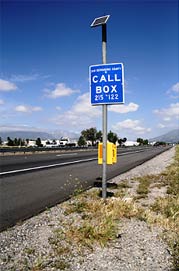A call box on Interstate 215 in the Inland Empire. Photo credit: SANBAG.
For decades, whenever you drive the freeways in Southern California, you see these blue signs with yellow boxes below the sign, all over the places. These things were known as “Call Boxes“. Call Boxes were used to provide help for motorists who were stranded on the freeways. For most of my life, I have seen a lot of these kinds of boxes, at least until mobile phones overtook the land-line phones at the end of the 2000’s.
Until the end of the 1990’s, Call boxes were found every 1/4 miles on most Southern California freeways. However, between in recent years, most call boxes on Southern California freeways were removed for two reasons: One was, the increasing costs to maintain call boxes. California’s budget crisis of recent years, made keeping boxes like these a challenge because there was not enough money to go around. The other was the usage of these boxes fell by 80 percent between 2001 and 2011, according to a study by MTC (Metropolitan Transportation Commission) in Northern California, as more and more drivers use mobile phones for help instead of call boxes. According to the OCTA (Orange County Transportation Authority), only half of the 585 Call Boxes that were installed on Orange County freeways in the 1980’s are still in operation.
Each call box are marked by the route number of the freeway (such as the 5, 10, 101, 210, 405, etc.), followed by the post mile number. Freeway Call Boxes are placed on the right shoulder of the freeway by local governments, not Caltrans. This means, entities like the Los Angeles County MTA (Metropolitan Transportation Authority), the OCTA, or SANBAG (San Bernardino County Governments) are in charge of those little boxes, and therefore they are the ones that put up (or remove) the call boxes.
Today, when I drive on a Los Angeles-area freeway, I now only see a few call boxes when I am on the freeway; there is only one call box per mile. On some freeways, Call Boxes are all but gone. In the coming years, if current trends continue, more and more call boxes will be removed from the freeways. Eventually, call boxes on Southern California freeways will become just memory of my younger days.


Pingback: Button Copy Freeway Signs | L.A.'s Forgotten Treasures
My grandfather, Supervisor Kenneth Hahn, started the call box system when I was a child. It was a huge need prior to cell phones!
Katy, call boxes have been around for more than 40 years (cell phones did not exist until the 1980’s) and there were two generations of call boxes. The first ones were more primitive and sorted by freeway name and postmile. The current version, which first appeared in the early 1990’s, had solar panels and were sorted by route number and postmile.
Pingback: Button Copy Freeway Signs – 5hknxslt
As of 2017, button copy signs on L.A. freeways are now scarce. They have been replaced with newer types of signs with exit numbers. On some freeways, there are no button copy signs left. Also, call boxes still exist, but less common than 20 years ago.
The call boxes are disappearing but the tax that put them up there isn’t. I want my refund.
Nick, I am aware that call boxes are now gone from some freeways in California. Due to smartphones becoming more commonplace now, call boxes are rarely used by motorists. However, I am not aware that the taxes that put those things up is still law. I think the taxes should be re-directed to road maintenance if nobody uses call boxes (practically obsolete).
It is important to remember that call boxes are anything but obsolete with spotty or nonexistent cell reception. A few are satellite powered or hooked up to landlines. But, even cellular powered ones, with their large antennas can sometimes pick up a signal where a personal phone cannot. On Highway 128 between Napa and Winters, I had a flat tire and my rental cat had no jack or lug wrench. And, especially considering the sun was about to set, I am not sure I would have been comfortable changing the tire myself anyway.
There was no cell reception. I contemplated for a few awful minutes whether to sleep in the car, try to walk enough miles to find a cell signal or drive on the flat tire. I chose the last option. It could have damaged the wheel and tire, but I saw no other option.
But, after a short distance, I saw the call box (this one is hooked up to a landline). I had forgotten about them until then, but I remembered at that moment when I asked my dad what they were when I was a kid. The dispatcher answered and connected me to triple AAA. The tow truck driver came and changed my tire and I made it home to Sacramento.
https://www.google.com/maps/place/6478+CA-128,+Napa,+CA+94558/@38.4694652,-122.14457,17z/data=!3m1!4b1!4m5!3m4!1s0x8084e29b82a64907:0x57ebcd6cecd9e334!8m2!3d38.469461!4d-122.1423813
I am very thankful for that call box. I think any discussion of call boxes needs to include stories like mine.